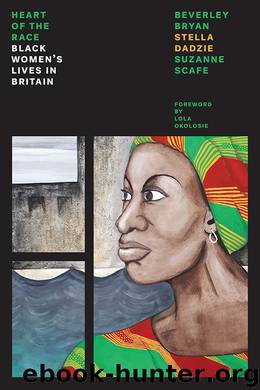The Heart of the Race by Beverley Bryan & Stella Dadzie & Suzanne Scafe

Author:Beverley Bryan & Stella Dadzie & Suzanne Scafe
Language: eng
Format: epub
Publisher: Verso Books
In 1964 Claudia’s efforts were cut short when she died in her sleep in Christmas Day as a result of a stroke. Her funeral was a testimony of the many who knew, loved and drew strength from her. In the words of Paul Robeson, Claudia Jones ‘continued in her day the heroic tradition of Harriet Tubman, of Sojourner Truth – the struggle for negro liberation and women’s rights, for human dignity and fulfilment’.
One of the main areas of Claudia Jones’s work, which was left for others to continue, was agitation around the 1962 Commonwealth Immigration Act. In the aftermath of the street confrontations of 1958, dubbed ‘riots’ by the media, the British government gave open sanction to racism and legitimised public assumptions that Black people were the ‘problem’. The logical extension of this argument was that our numbers needed to be controlled. The Act was designed to regulate the numbers of Black people entering Britain by allocating us specific immigration categories. Men and women applying to enter Britain were given vouchers, depending on whether they were professionally qualified, skilled or unskilled. By 1964, no Category C immigration of unskilled workers was allowed. The effect of this was to split our families, particularly where we had applied for our older children to join us here. A direct consequence of this was that many Black women decided to send for children who had been left behind in the Caribbean, out of fear that they might be permanently prevented from visiting or joining families here. As Britain’s economic boom began to decline it seemed that she no longer required our labour – or our ‘superfluous appendages’.
The 1962 Immigration Act revealed that the government was more than prepared to institutionalise the rampant racism of its citizens. Other organisations felt emboldened to put their own racist views on record. The police, too, were becoming more openly hostile, both ignoring and initiating attacks on Black people. This created rifts which would widen over the years and result in open antagonism between our community and the ‘forces of law and order’. The very first documented evidence of police brutality, ‘Nigger-Hunting in England’, was delivered to the West Indian Standing Conference and later published in 1966, confirming what was already a widespread experience for Black men and women alike although it provoked little reaction among the British people, who saw ‘Dixon of Dock Green’, the friendly local bobby, as the typical British policeman.
It was developments such as these which spurred our communities into greater mass organisation. A variety of Black organisations was set up during the early sixties whose brief was to organise against both discriminatory legislation and racist practices. In 1965 many of these newer groups came together with those which had been longer established in the federal structure of CARD (Campaign Against Racial Discrimination), an organisation which linked Asian and Afro-Caribbean activists with Labour Party liberals. It was a contradictory and complex alliance that was doomed to fail as the variety of politics within it came to the fore and clashed.
Download
This site does not store any files on its server. We only index and link to content provided by other sites. Please contact the content providers to delete copyright contents if any and email us, we'll remove relevant links or contents immediately.
| African-American Studies | Asian American Studies |
| Disabled | Ethnic Studies |
| Hispanic American Studies | LGBT |
| Minority Studies | Native American Studies |
Cecilia; Or, Memoirs of an Heiress — Volume 1 by Fanny Burney(32435)
Cecilia; Or, Memoirs of an Heiress — Volume 2 by Fanny Burney(31871)
Cecilia; Or, Memoirs of an Heiress — Volume 3 by Fanny Burney(31856)
The Great Music City by Andrea Baker(31359)
We're Going to Need More Wine by Gabrielle Union(18969)
All the Missing Girls by Megan Miranda(15579)
Pimp by Iceberg Slim(14395)
Bombshells: Glamour Girls of a Lifetime by Sullivan Steve(13976)
Talking to Strangers by Malcolm Gladwell(13222)
Norse Mythology by Gaiman Neil(13208)
Fifty Shades Freed by E L James(13157)
For the Love of Europe by Rick Steves(13020)
Mindhunter: Inside the FBI's Elite Serial Crime Unit by John E. Douglas & Mark Olshaker(9201)
Crazy Rich Asians by Kevin Kwan(9167)
The Lost Art of Listening by Michael P. Nichols(7408)
Enlightenment Now: The Case for Reason, Science, Humanism, and Progress by Steven Pinker(7237)
The Four Agreements by Don Miguel Ruiz(6634)
Bad Blood by John Carreyrou(6552)
Weapons of Math Destruction by Cathy O'Neil(6146)
